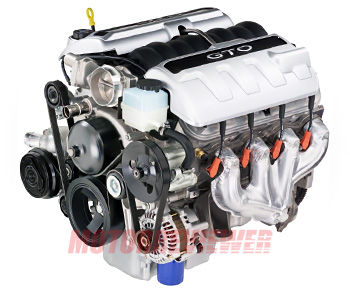GM 6.0L LS2 Engine Specs, Problems, Reliability, Info

6.0L LS2 Small Block V8 Engine Info
The GM 6.0 LS2 is an all-aluminum gasoline 6.0-liter NA fourth-gen Small Block V8 engine, introduced first in the 2005 Chevrolet Corvette C6 as a new base engine with power output of 400 hp (298 kW) and 400 lb-ft (542 Nm) of torque. This motor doesn't have anything in common with the 7.5-liter (455 cubic-inches) Pontiac LS2 RPO engine produced between 1973 and 1974. The GM LS2 is based on the 5.7-liter Gen3 LS1 engine and uses the same cam-in-block architecture and 4.400-inch bore centers, but features several new design cues and technologies. Let's find out how this 6.0-liter small block V8 is built, learn about its specs, reliability, pros and cons.
6.0L LS2 Engine Overview
The main part of any engine is the cylinder block. The LS2 has a lightweight cast aluminum block with cast iron sleeves and a 90-degree angle between the cylinder banks. It features six-bolt main caps, a cast iron crankshaft, forged powdered metal connecting rods, and flat-top cast aluminum pistons. The block came with a chain-driven single camshaft and hydraulic roller lifters.
On top, there are aluminum 8-valve (two per cylinder) cylinder heads with a 15-degree valve angle, roller rocker arms, cathedral intake ports, and D-port exhaust. The LS2 cylinder heads are very similar to what was used on the LS6 engine (the same 243 stamp in the castings). But both intake and exhaust valves are made of steel and have solid stems, instead of sodium-filled stems. Intake valve diameter is 2.000 inches (50.8 mm), exhaust valve diameter — 1.575 inches (40.0 mm). Camshaft specs (2005 Corvette, 2005-06 GTO): 204/213 duration (intake/exhaust), 0.520 in./0.521 in. valve lift (intake/exhaust). Steel pushrods measure 7.385-inches long. The LS2 also has a revised positive crankcase ventilation system, which has its pickup in the valley cover, beneath the intake manifold, instead of the valve cover.
The LS2 is equipped with a conventional sequential port-fuel injection system. LS2 injectors are rated at 34 lb/hr at 58 psi. The intake manifold is made of plastic. It came with 4-bolt electronic throttle body. The size of throttle valve is 90 mm (3.55-inches). The engine also came with a modern, electronically controlled, coil-near-plug ignition system. Up to mid-2006, engines featured the 24-tooth reluctor wheel, then they were upgraded to a more modern 58-tooth setup. Most LS2 engines use E38 or E40 engine controllers.
The End Result
Debuted in 2005, the LS2 engine produced 400 hp at 6,000 rpm and 400 lb-ft (542 Nm) at 4,400 rpm, and that was really close to HO LS6 motor. Some LS2s, modified in Australia, show even more power: 412 hp (307 kW) and 412 lb-ft (559 Nm) of torque. The LS2 is also the foundation for the NASCAR Specification Engine, which has been an optional power unit in the Camping World Series East and West divisions since 2006.
L76 Engine
The 6.0-liter V8 named as L76 is derived from the LS2. The most notable feature in the design of L76 is GM's Active Fuel Management (AFM) technology. It is a cylinder deactivation system that can turn off half the cylinders when the load is low, saving fuel. The LS6 came in two versions: one for GM trucks and the other for Holden and Pontiac sedans. It still uses LS2 aluminum block, but has different heads ("823" casting number) with rectangle intake ports, bigger valves, new camshaft, and so on.
Engine Specs
Oil recommendations and capacity may vary depending on the car model, year, and market. Please check the service manual specific to your vehicle!
Most Common LS2 Engine Problems
The GM 6.0-liter LS2 engine is highly regarded for its reliability and robustness. The majority of owners had a positive experience with their LS2 motors and had minimal issues that required repairs. Of course, with any motor, some failure will occur over time, especially if it hasn't been properly maintained. Here below are some potential issues and the most common problems with the LS2 small-block engine.
- Harmonic Balancer Wobble: The harmonic balancer, or torsional damper, is a weak spot on all LS motors, including the LS2. Harmonic balancer wear is a relatively common issue on many C6 Corvettes and leads to vibrations. It is crucial to tackle this issue to avoid further damage to the crankshaft.
- Oil consumption: The engine can develop problems with oil consumption over time. This usually happens at higher mileage, but it can also occur on relatively new engines, especially if they are not properly maintained or abused hard.
- Thrust Bearing Failure: The LS2 thrust bearings do not last very long (often caused by improper assembly). They wear out quickly, leading to excessive crankshaft endplay over time.
LS2 Reliability Summary
The GM 6.0 LS2 motor is generally considered as a very reliable and durable engine, which has fewer electronics and strong bottom-end components. It is also known for its longevity. Properly maintained LS2 often exceeds the 200,000 mile mark. Even if something goes wrong with the engine, there is a vast aftermarket with proven solutions to any potential problems. However, as for any engine, regular maintenance is crucial for its long-term dependability. It is essential to regularly change the oil, use high-quality motor oil, premium fuel, and good parts and filters.
